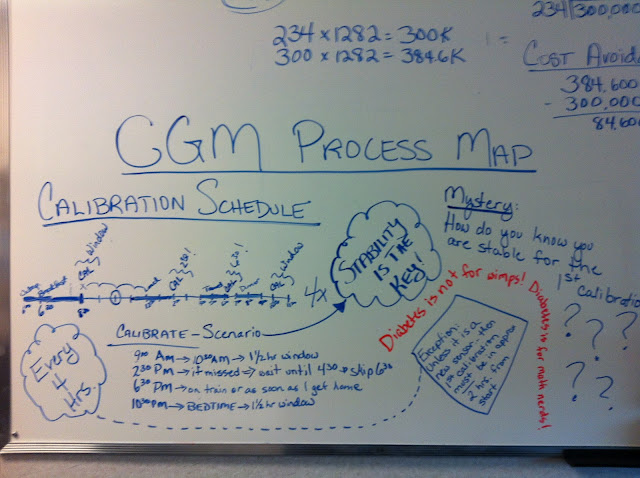When I started a month ago, I had a colourful printed list about how to insert sensors, how to calibrate, and other CGM essentials. This is what the graph looked like in the beginning. I was a happy camper. I was going to get my BGs in some sort of order.
I had hope. I was fresh. I was excited.
 |
| See that beautiful flat line? |
But things deteriorated. I was starting to see graphs that looked like this one:
 |
| Jamie's Very Very Bad No Good Diabetes Day |
Then there came that fateful night last Sunday - a work night - when my CGM was busy alerting me all night. That's every hour folks. By morning I was a ragged wreck.
So the next day I called Medtronic, and later had an enlightening conversation on Twitter with some awesome DOC (Diabetes Online Community) members, that the picture came together for me.
So here are the basics that I wasn't really getting:
- Calibrate only when your BGs are stable
- CGM must be calibrated at least twice a day, or it can shut down.
- Calibrate* 3-4 times a day, at least 4 hours apart, and wait for 1/2 hour before eating/bolusing
- Even if your BG is high, don't do any corrections if you are calibrating - either calibrate and wait for 15 minutes, or if BG is too high, it might not be a good idea to calibrate right then
- Keep well hydrated
- Make sure your ISIG value according to CGM is good (still trying to figure out what "good" is... I'm still on that mission
- Keep well hydrated
- Make sure your pump/CGM is located close to the transmitter/sensor. Apparently it was too much for the manufacturer to use a transmitter with enough power to reach from one side of my waist to the other (and really... I don't think I'm that fat!)
- Oh yeah, keep well hydrated
*Calibration is when you give CGM info correlating it with your meter, which is the gold standard for testing your blood, with a variance allowed of +/- 20%
(For those looking for really good info about CGMs, please check out Jeff Mather's Dispatches post What I've Learned About My CGM. Thank's Jeff!)
By the way, no one told me before speaking with the DOC that steps 5, 7 and 9 were essential steps. (I love the DOC for this kind of thing).
Apparently if one doesn't follow these steps, you can get a crazy-*ss graph like the one above.
And yeah, that's just the beginning...
Remember my Whiteboard Advocacy campaign that I was running at work last year? Well I've repurposed the board (aside from work purposes of course)... and started a Calibration Process Map... figuring out what the best time is to calibrate the darn thing.
This was my first attempt ... doesn't look good. But it was a good start.
First of all... it looks like I need 26 hour day to make this puppy work. See those thick lines up there? That's when I figured that I shouldn't calibrate.
And what I was doing before? 4 times a day? Stable? Ok, go for it. Apparently that's wrong, wrong, wrong. And yeah, I don't drink... aside from the much needed coffee.
Things have settled down a bit... I was having Whiteboard Separation Anxiety this weekend, and was using my kitchen chalkboard, which usually is host to my shopping list.
Anyway, this is what it looked like this weekend:
And so things have been looking a little better the last couple of days.
So I've travelled some rocky roads, and now I think I can make this puppy work. I have hope.




